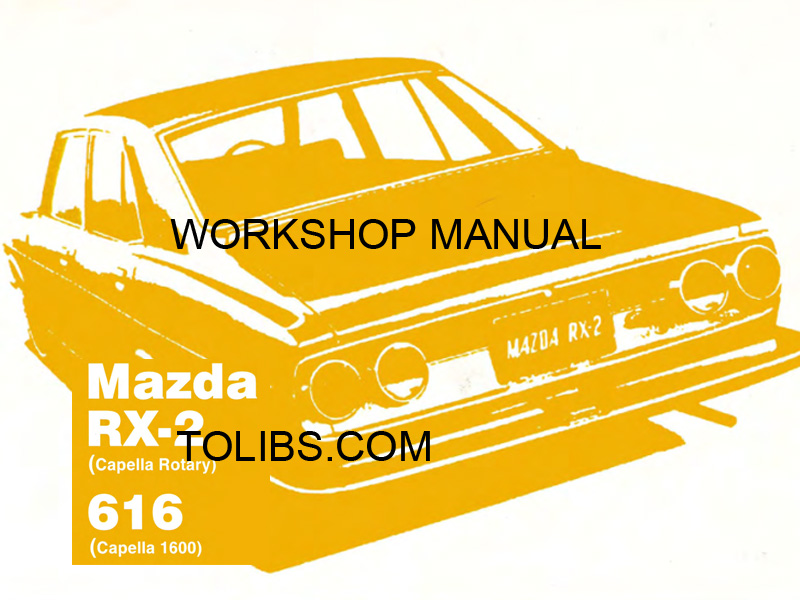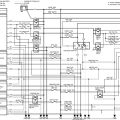Mazda RX-2 Capella Rotary and Capella 1600 Workshop Manual

MAZDA RX-2 (CAPELLA ROTARY) workshop Manual
NOTE : Capella Rotary is the nickname of the MAZDA RX-2 which is used in some markets.
ENGINE
RX-2 is mounted with a 2-rotor type rotary piston engine of Toyo Kogyo’s unique design. Its single chamber capacity is 573 cc (35.0 cu. in) and the compression ratio is 9.4 : 1. The performance is shown in Fig. 1-4.
The main component parts of the rotary piston engine are entirely different from those of the conventional reciprocating engine. The rotor which corresponds to the piston of the reciprocating engine makes a rotary motion due to the explosion pressure occurring in the chamber formed by the rotor housing and the side housing which correspond to the cylinder of the reciprocating engine. This rotary motion of the rotor is converted into the rotary motion of the eccentric shaft and is then produced as output through the flywheel.
REMOVING THE ENGINE
To remove the engine for overhauling, proceed as descreibed in the following :
- Remove the bonnet.
- Protect the fender with a cover.
- Drain the cooling water.
- Drain the engine lubricating oil.
- Remove the air-cleaner.
- Remove the fuel pipe from the carburettor.
- Disconnect the accelerator cable and the choke cable from the carburettor.
- Disconnect the wiring from the starting motor.
- Disconnect the wiring from the alternator and the water temperature gauge unit.
- Disconnect the high-tension cables from the distributors and the spark plugs.
- Disconnect the wire of the oil pressure switch.
- Remove the water hoses from the engine.
- Remove the heater hose from the engine.
- Remove the oil hoses from the front cover and rear housing of the engine, and remove the oil hose clip on the engine mounting bracket.
- Remove the radiator upper shroud.
- Remove the alternator.
- Remove the cooling fan from the eccentric shaft pulley.
- Remove the starting motor.
- Remove the clutch release cylinder and place it on the frame.
- Disconnect the exhaust pipe from the manifold.
- Remove the bolts securing the clutch housing to the rear housing of the engine.
- Remove the hot air duct from the exhaust manifold.
- Support the transmission with a suitable jack.
- Remove the bolts from each engine mounting. For easy disconnection, it is recommendable to remove the two small bolts on left-hand side and a large nut on right-hand side as shown in Fig. 1-9.
- Install a suitable lifting sling on the engine hanger bracket of the front rotor housing. Attach the sling to a hoist or other lifting device and take up all slack.
- Pull the engine forward until it clears the clutch shaft. Then, lift the engine from the vehicle.
- Disconnect the connecting rod of the oil metering pump at the carburettor side.
- Remove the intake manifold, with carburettor and exhaust manifold.
- Remove the engine bracket.
- Mount the engine on the engine stand (49 0107 680A, 49 0813 005 and 49 0820 006).
DISASSEMBLING THE ENGINE
Engine overhaul should be done in the following order after dismounting the engine from the vehicle:
- Remove the water pump pulley.
- Remove the water pump.
- Remove the distributors from the front cover.
- Remove the spark plugs.
- Remove the oil filter from the rear housing.
- Attach the ring gear brake (49 0820 060) to the flywheel, Remove the eccentric shaft pulley with key.
- Remove the clutch assembly and clutch disk.
- Straighten the tab of the lockwasher and remove the flywheel nut using the flywheel box wrench (49 0820 035).
- Remove the flywheel by using the flywheel puller (49 0823 300), turning the handle and lightly hitting the head of the puller.
- Remove the oil pan.
- Remove the oil strainer.
- Remove the oil metering pump from the front cover.
- Loosen the bolts attaching front cover and remove the cover.
- Remove the spacer, distributor drive gear, oil pump drive gear, balance weight, thrust plate, and needle bearing in that order from the eccentric shaft.
- Straighten the lockwashers of needle bearing housing tightened by six bolts and loosen the bolts. Remove the needle bearing housing, needle bearing and thrust washer.
- Loosen the tension bolts in the order as shown in Fig. 1-18.
- Remove the front housing.
- Remove the corner seals with springs and the side seals with springs and place them in the seal case (49 0813 250) following the marks which are made at the nearest portion of each seal on the rotor side face. These marks are made in order to prevent each seal from changing its original position when reassembling.
- Remove the sealing rubbers and the “O” rings from between the front housing and the rotor housing.
- Hold the rotor housing down by hand to prevent it from moving up, then pull the tubular dowels by using the dowel puller (49 0813 215).
- Install the rotor clamp (49 0813 230) by allowing the front rotor housing to move up to the required level so as not to damage the apex seals, then remove the front rotor housing.
- Remove the apex seals and springs after removing the rotor clamp. When removing the apex seal, put an identification mark on the bottom of the apex seal so that, when reassembling the engine, the apex seal can be incorporated to the correct location and in the correct direction. Never put a mark with a punch, notch or the like.
- Remove the rotor from the eccentric shaft and place it upside down on a clean cloth or rubber.
- Remove the seals on the rear side of the rotor.
- Extract the tubular dowels from the intermediate housing with the dowel puller (49 0813 215).
- Remove the intermediate housing. Due to the eccentricity of the shaft at the journal portion, the intermediate housing must be removed by sliding it beyond the journal portion of the front rotor while holding the intermediate housing up and at the same time pushing up the eccentric shaft.
- Remove the eccentric shaft.
- Repeat the above procedure to remove the rear rotor housing and the rear rotor assembly.
ENGINE INSPECTION AND REPAIR
Inspection of front housing assembly
- Check for traces of gas or water leakage.
- Check for wear and damage on the surfaces contacting each seal.
- Check for wear, cracks or broken teeth on the stationary gear.
- Check for wear, scratching, flaking, and other damages to the main bearing.
Cleaning the front housing
It is recommended that the following steps are taken to remove carbon and sealing agent from the front housing.
- Carbon Deposits Use an extra-fine emery paper. When a carbon scraper is to be used, be careful not to damage the matching surfaces of the housing.
- Sealing Agent Use a cloth or a brush soaked in a solution of ketone or thinner.
Inspection of front housing for distortion
Place a straight edge on the housing surface as shown in Fig. 1-29 and measure the clearance between both with a feeler gauge. The housing must be replaced if the distortion is found to be more than 0.04 mm (0.002 in).
Inspection of front housing for wear
Wear of the matching surfaces of the front housing and rotor should be measured with a dial indicator. The front housing must be replaced if the wear exceeds 0.1 mm (0.004 in). There is a tendency of increased wear at both ends of the minor axis of the front housing. The effective depth of this wear is small.
Checking the main bearing clearance
The main bearing clearance is measured by checking the inner diameter of the main bearing and the outer diameter of the journal section of the eccentric shaft. The standard main bearing clearance is 0.04 ~ 0.07 mm replaced (0.0016 if the clearance 0.0028 in), becomes and the more bearing than 0.10 mustmm be (0.0039 in).
Removing and assembling the stationary gear and main bearing
When this work is required, proceed in the following steps.
- Remove the bolts securing the stationary gear to the housing.
- Press out the stationary gear with the main bearing puller and installer (49 0813 235).
- Mount the stationary gear on a vise. Remove the bearing lock pin by using the lock pin remover (49 0820 260).
- Remove the adapter from the main bearing puller and installer (49 0813 235) and use it to extract the main bearing as shown in Fig. 1-34
- Attach the adapter on the main bearing puller and installer and use it to press the bearing into the gear until the adaper touched the gear flange. Be sure to match the oil holes of bearing and gear, as shown in Fig. 1-35.
- Insert the lock pin to prevent the bearing from turning.
- Press in the staitionary gear to the housing with main bearing puller and installer (49 0813 235), aligning the slot of the stationary gear tlange and the dowel pin, as shown in Fig. 1-36.
- Tighten the bolts attaching stationary gear.
Intermediate Housing
Inspection for distortion or wear of the intermediate housing should be carried cut in the same way as described for the front housing. Refer to par. 1-C-1.
Rear Housing
Inspection of the rear housing is carried out according to Par. 1-C-1, but the following point must be inspected as well.
Checking the oil seal
Check for wear and damage. If trace of oil leakage is found, replace the oil seal.
Replacing the stationary gear
- Remove the bolts attaching the stationary gear to the rear housing.
- Using the main bearing puller and installer (49 0813 235), extract the stationary gear.
- Put a thin film of grease on the “0” ring and place it in the groove of the stationary gear.
- Apply sealing agent to the stationary gear flange.
- Install the stationary gear on the rear housing while being careful not to damage the “O” ring and to match the slot of the stationary gear flange to the dowel pin of the rear housing.
- Tighten the bolts attaching the stationary gear.
Rotor Housing
Checking the rotor housing
- Check for exfoliation, damage or cracks on the chromium-plated surface. If any of these conditions is found, replace the rotor housing.
- Check for traces of gas or water leakage along the inner margin of each side face of the rotor housing.
Cleaning the rotor housing
- Remove the sealing agent by wiping with a cloth or brush soaked in a solution of ketone or thinner.
- Remove carbon from the inner surface of the rotor housing by wiping with cloth. Soak the cloth in a solution of ketone or thinner when it is difficult to remove.
- Remove deposits and rust from the cooling water passages.
Inspection of rotor housing distortion
Measure the distortion of the rotor housing surface at the position shown in Fig. 1-41, by using a straight edge and a feeler gauge. Replace the part with a new one if the distortion is found to be more than 0.04 mm (0.002 in).
Measuring the rotor housing width
Measure the width of the rotor housing at points close to the trochoid surface by using a micrometer. Measurements must be taken at least 8 points. If the difference between the maximum value and the minimum value exceeds 0.08 mm (0.0031 in), the rotor housing must be replaced with a new one, as there is a possibility of gas or water leakage.
Inspection of combustion condition and gas leakage
- The combustion condition can, to a certain extent, be judged as in the case of reciprocating engines by the color and quantity of carbon on the rotor. Combustion can be said to be good if the color of carbon is brown. Generally carbon on the leading side seen from the direction of rotation is brown, while the trailing side shows black color. It should be noted that this color varies according to operating conditions just before the engine is dismantled.
- Gas leakage can be judged by checking the color of the rotor side surface for blow-by traces originating from the side seals and corner seals.
Oil seal inspection
- Check for wear and damage of the oil seal lip contacted with the sliding surface of the side or intermediate housing. If the contact width is more than 0.8 mm (0.031 in), the oil seal should be replaced with new one.
- Check the oil seal protrusion shown in Fig. 1-44. It should be more than 0.5 mm (0.02 in).
Inspecting the gap between side housing and rotor
The clearance can be measured by taking the width of the rotor housing and the width of the rotor. The standard clearance is0.13~0.17 mm (0.0051- 0.0067 in). If it is more than 0.17 mm (0.0067 in) replace the rotor and gear assembly. If the clearance is less than specification, there is a possiblity that the internal gear locked with 6 double pins is loose.
Inspecting the land protrusion
Check the land protrusion of the rotor by placing a straight edge over the land and measuring the clearance between the rotor face and straight edge with a0.006 feelerin). gauge. If it It should is less be than 0.10 specification, - 0.15 mm (0.004 there is a possibility of the rotor touching the side housing at places other than the land, causing wear of damage.
Inspecting the rotor bearing
Check for wear, flaking or scratches on the bearing. If any of these conditions is found, replace the bearing. The bearing clearance can be measured by taking the inner diameter of the rotor bearing and the outer diameter of the eccentric shaft journal. The standard clearance is 0.05 - 0.09 mm (0.0020 - 0.0035 in). Replace the bearing if it is more than 0.10 mm (0.0039 in).
Replacing the rotor bearing
- Insert the expander (49 0813 245) into the bearing to prevent the deformation of the rotor bearing when drilling a hole.
- Drill a hole of 3.5 mm (0.14 in) diameter and about 7 mm (0.28 in) depth in the locking screw which holds the bearing on the rotor. And then, remove the expander.
- Place the rotor on the support so as to face the internal gear upward. Using the rotor bearing puller and installer (49 0813 240) without its adapter ring, press out the bearing, being careful not to damage the internal gear.
- If the bore in the rotor is damaged while removing the bearing, finish the bore with emery paper and blow with compressed air.
- Place the rotor on the support so as to face the internal gear upward. Press fit a new bearing using the rotor bearing puller and installer (49 0813 240) with its adapter removed screws until the oil hole of the bearing matches the oil hole on the apex side of the rotor, and the bearing and the boss become flush.
- Insert the expander (49 0813 254) into the bearing, and then drill a hole of 3.5 mm (0.14 in) diameter and about 7 mm (0.28 in) depth at approximately 7 mm (0.28 in) to the left or right from the original location of the locking screw hole. It must be made to the same direction from each original hole. The center of the hole must be 0.5 mm (0.02 in) from the rotor bore.
- Thread the hole with an M4, P=0.70 mm tap.
- Tighten the locking screws and stake them into positions with a punch to prevent them from working out.
- Wash the rotor thoroughly and blow with compressed air.
Inspecting the gap between side seal and groove
Measure the gap with a feeler gauge. The standard and clearnace the side is 0.04 seal -must 0.07 bemm replaced (0.0016 if it- exceeds 0.0028 0.1 in), mm (0.0039 in).
Inspecting the gap between comer seal and groove
The standard in) andgaptheis limit 0.020is~0.08 0.048 mmmm (0.0031 (0.0008 in).- This gap enlargement shows uneven wear of the corner seal bore, which occurs when the enginei is operated with dust entering through a clogged element, damaged air cleaner or any other cause. When the wear is permitted to increase, the engine power will be reduced and the engine will become hard to start.
The extent of wear of the comer seal bore is determined by the bar limit gauge (5619 91 100) and classified into three conditions:
- Neither end of the gauge does not go into the bore. This means that the gap conforms to the specifications.
- While the go-end of the gauge goes into the bore, the not-go-end does not. This means the gap is more than stnadard dimension and less than the limit. In this case, replace the corner seal with a 0.03 mm (0.0012 in) oversize one, leaving the rotor side as it is.
- If the both ends of the gauge go into the bore, it means that the gap exceeds the limit of 0.08 mm (0.0031 in). Rework the comer seal bore with the jig (5870 94 1520) and reamer (5363 91 180 ) to 11.2 + 0 003 mm (0-4410 + 0 0001 diameter following the procedure in Par. 1-C-6, g, and fit a 0.2 mm (0.0079 in) oversize corner seal.
Reboring corner seal groove
- Remove carbon, rust and other deposits from the rotor surface especially the apex seal groove, being careful not to damage.
- Install the jig ( 5870 94 152 ) the rotor and tighten the collect bar being careful not to damage the rotor bearing and apex seal groove.
- Ream a hole with the reamer ( 5363 91 180 ) by hand applying sufficient engine oil as the coolant. When feeding the reamer, it must be turned by about 20 rotations or over before the reaming work is accomplished completely.
- Remove the reamer and jig from the rotor being careful not to damage the rotor. Repeat the same manner as above to make other holes of the rotor.
- Thoroughly clean the rotor, and check and comfirm by visual inspection how the reaming hole of the corner seal is drilled through and if there is any damage to the rotor.
- Fit a 200u oversize corner seal of which surface is hard-chromium-plated. Check and comfirm whether the gap between corner seal and groove is under specification.
Inspecting the gap between side seal and corner seal
Check the gap with the side seal and corner seal installed on the rotor. Insert a feeler gauge between the rear of the side seal (against the turning direction of rotor) and the corner seal. When this clearance is too large, gas-sealing performance becomes poor. The side seal must be replaced if the gap between the side seal and the comer seal exceeds 0.4 mm (0.016 in).
When a side seal is replaced, adjust the gap between side seal and corner seal by grinding the opposite end of the side seal to the rotor rotating direction along the round shape of corner seal with a fine 0.006 file soin).
Note: Be sure to use the right one when installing a new side seal as there are four different types, namely, the front inner, front outer, rear inner, and rear outer seal.












